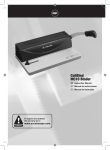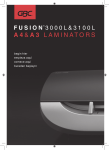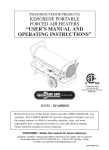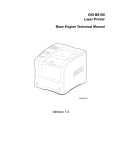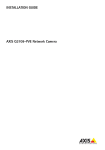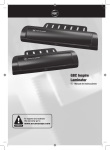Download User Manual X20M DLP Projector User Manual
Transcript
X20M DLP Projector User Manual ACCO Europe www.accoeurope.com Made in Taiwan 2 TA B L E O F C O N T E N T S Usage Notice • Precautions . . . . . . . . . . . . . . . . . . . . . . . . . . . . . . . . . . . . . . . . . . . . . . . . . . . . . . . . . . . . . . . . . . . . . . . . . . . . . . . . . 4 Introduction • Product Features . . . . . . . . . . . . . . . . . . . . . . . . . . . . . . . . . . . . . . . . . . . . . . . . . . . . . . . . . . . . . . . . . . . . . . . . . . . 5 • Package Overview . . . . . . . . . . . . . . . . . . . . . . . . . . . . . . . . . . . . . . . . . . . . . . . . . . . . . . . . . . . . . . . . . . . . . . . . . 6 • Product Overview . . . . . . . . . . . . . . . . . . . . . . . . . . . . . . . . . . . . . . . . . . . . . . . . . . . . . . . . . . . . . . . . . . . . . . . . . . 7 • Main Unit . . . . . . . . . . . . . . . . . . . . . . . . . . . . . . . . . . . . . . . . . . . . . . . . . . . . . . . . . . . . . . . . . . . . . . . . . . . . . . . . 7 • Panel Control . . . . . . . . . . . . . . . . . . . . . . . . . . . . . . . . . . . . . . . . . . . . . . . . . . . . . . . . . . . . . . . . . . . . . . . . . . . . 8 • Connection Ports . . . . . . . . . . . . . . . . . . . . . . . . . . . . . . . . . . . . . . . . . . . . . . . . . . . . . . . . . . . . . . . . . . . . . . . . 8 • Remote Control with Mouse Function and Laser Pointer . . . . . . . . . . . . . . . . . . . . . . . . . 9 • Laser Pointer Caution . . . . . . . . . . . . . . . . . . . . . . . . . . . . . . . . . . . . . . . . . . . . . . . . . . . . . . . . . . . . . . . . . . 9 Installation • Connecting the Projector . . . . . . . . . . . . . . . . . . . . . . . . . . . . . . . . . . . . . . . . . . . . . . . . . . . . . . . . . . . . . . . 10 • Powering On/Off the Projector . . . . . . . . . . . . . . . . . . . . . . . . . . . . . . . . . . . . . . . . . . . . . . . . . . . . . . . . . 11 • Power On the Projector . . . . . . . . . . . . . . . . . . . . . . . . . . . . . . . . . . . . . . . . . . . . . . . . . . . . . . . . . . . . . . 11 • Power Off the Projector . . . . . . . . . . . . . . . . . . . . . . . . . . . . . . . . . . . . . . . . . . . . . . . . . . . . . . . . . . . . . . 12 • Adjusting the Projected Image . . . . . . . . . . . . . . . . . . . . . . . . . . . . . . . . . . . . . . . . . . . . . . . . . . . . . . . . . 13 • Adjusting the Projector Height . . . . . . . . . . . . . . . . . . . . . . . . . . . . . . . . . . . . . . . . . . . . . . . . . . . . . . 13 • Adjusting the Projector Zoom/Focus . . . . . . . . . . . . . . . . . . . . . . . . . . . . . . . . . . . . . . . . . . . . . . . . 14 • Adjusting Projection Image Size . . . . . . . . . . . . . . . . . . . . . . . . . . . . . . . . . . . . . . . . . . . . . . . . . . . . 14 User Controls • Panel Control and Remote Control . . . . . . . . . . . . . . . . . . . . . . . . . . . . . . . . . . . . . . . . . . . . . . . . . . . 15 • On-Screen Display Menus . . . . . . . . . . . . . . . . . . . . . . . . . . . . . . . . . . . . . . . . . . . . . . . . . . . . . . . . . . . . . . . 16 • How to Operate . . . . . . . . . . . . . . . . . . . . . . . . . . . . . . . . . . . . . . . . . . . . . . . . . . . . . . . . . . . . . . . . . . . . . . . 17 • Image-I (Computer Mode) . . . . . . . . . . . . . . . . . . . . . . . . . . . . . . . . . . . . . . . . . . . . . . . . . . . . . . . . . . . 18 • Image-I (Video Mode) . . . . . . . . . . . . . . . . . . . . . . . . . . . . . . . . . . . . . . . . . . . . . . . . . . . . . . . . . . . . . . . . 19 • Image-II (Computer Mode) . . . . . . . . . . . . . . . . . . . . . . . . . . . . . . . . . . . . . . . . . . . . . . . . . . . . . . . . . . . 20 • Image-II (Video Mode) . . . . . . . . . . . . . . . . . . . . . . . . . . . . . . . . . . . . . . . . . . . . . . . . . . . . . . . . . . . . . . . . 21 • Audio . . . . . . . . . . . . . . . . . . . . . . . . . . . . . . . . . . . . . . . . . . . . . . . . . . . . . . . . . . . . . . . . . . . . . . . . . . . . . . . . . . . 22 • Language . . . . . . . . . . . . . . . . . . . . . . . . . . . . . . . . . . . . . . . . . . . . . . . . . . . . . . . . . . . . . . . . . . . . . . . . . . . . . . . 22 • Management. . . . . . . . . . . . . . . . . . . . . . . . . . . . . . . . . . . . . . . . . . . . . . . . . . . . . . . . . . . . . . . . . . . . . . . . . . . 22 Appendices • • • • Troubleshooting . . . . . . . . . . . . . . . . . . . . . . . . . . . . . . . . . . . . . . . . . . . . . . . . . . . . . . . . . . . . . . . . . . . . . . . . . . 24 Changing the Lamp . . . . . . . . . . . . . . . . . . . . . . . . . . . . . . . . . . . . . . . . . . . . . . . . . . . . . . . . . . . . . . . . . . . . . . 26 Specifications . . . . . . . . . . . . . . . . . . . . . . . . . . . . . . . . . . . . . . . . . . . . . . . . . . . . . . . . . . . . . . . . . . . . . . . . . . . . . 27 Compatibility Modes . . . . . . . . . . . . . . . . . . . . . . . . . . . . . . . . . . . . . . . . . . . . . . . . . . . . . . . . . . . . . . . . . . . . . 28 FCC Notice This equipment has been tested and found to comply with the limits for a Class B digital device, pursuant to Part 15 of FCC Rules. These Limits are designed to provide reasonable protection against harmful interference in a residential installation. Trademarks Trademark are the rights of their respective owners. 3 USAGE NOTICE ! Ì ! Ì ! Ì ! Ì ! Ì ! Ì ! Ì ! Ì ! Ì WARNING Do not look into the lens. The bright light may hurt your eyes. WARNING To reduce the risk of fire or electric shock, do not expose the product to rain or moisture. WARNING Please do not open or disassemble the product as this may cause electric shock. WARNING When changing the lamp, please allow unit to cool down, and follow all changing instructions. WARNING This product will detect the life of the lamp itself. Please be sure to change the lamp when it shows the warning messages. WARNING After changing a new lamp. please reset the lamp life from OSD menu. WARNING Before switching off the product, please keep the cooling fan running for a few minutes. WARNING When connecting the projector to computer, please turn on the projector first. WARNING To reduce the risk of injury to the eyes, do not look directly into the laser light on the remote control and do not point the laser light into anyone’s eyes. This remote control is equipped with a Class II laser that emits radiation. ! Ì WARNING When the lamp reaches the end of its life, it will burn out and may make a loud popping sound. If this happens, the projector will not turn back on until the lamp module has been replaced. To replace the lamp, follow the procedures listed under Changing the lamp on page 26. PRECAUTIONS Follow all warnings, precautions and maintenance as recommended in this User’s Guide to maximise the life of your unit. DO ■ Turn off the product before cleaning ■ Use a soft cloth moistened with mild detergent to clean the display housing ■ Disconnect the power plug from AC outlet if the product is not being used for a long period of time DON’T ■ Block the slots and opening on the unit provided for ventilation ■ Use abrasive cleaners, waxes or solvents to clean the unit ■ Use under the following conditions: ■ Extremely hot, cold or humid conditions ■ In areas susceptible to excessive dust and dirt ■ Near any appliance generating a strong magnetic field ■ Place in direct sunlight 4 INTRODUCTION PRODUCT FEATURES This product is an XGA single chip 0.7” DLP™ projector. It’s outstanding features are: ■ True XGA, 1024 x 768 addressable pixels ■ 2.9 kg (6.4 lbs) compact design ■ Single chip DLP™ technology ■ SXGA compression and VGA, SVGA re-sizing ■ 200 Watts user replaceable UHP lamp ■ Mac compatible ■ NTSC / NTSC4.43 / PAL / PAL-M / PAL-N / SECAM and HDTV compatible ■ Full function remote with mouse control and laser pointer ■ High-tech DVI Connection for digital and analog video connectivity ■ High definition TV compatibility ■ User-friendly multilingual on-screen display menu ■ Advanced electronic keystone correction ■ User-friendly control panel ■ Luxurious carrying case included 5 INTRODUCTION PACKAGE OVERVIEW This projector comes with all the items shown below. Please ensure your unit is complete. Contact your dealer immediately if anything is missing. Power Cord Projector with lens cap S-Video Cord VGA Cord Audio Cable Jack / RCA Composite Video Cable DVI to D-Sub Cable Remote Mouse Y Cable User’s Guide Warranty Card Remote Control with Mouse Function and Laser Pointer Carry Case Batteries x 2 X20M DLP Projector Quick Start Guide 1 Power Cord 2 VGA Cable 3 S-Video Cable 4 Audio Cable Jack/RCA 5 Composite Video Cable 6 DVI to D-Sub Cable 7 Remote Mouse Y Cable 8 D-Sub to RCA Cable for Digital Tuner Output HDTV/Component (optional) Video Output 4 1 5 3 RS232 7 6 S-Video Output USB RGB 2 Connecting the Projector 1 Make sure the projector and your computer are turned off 2 Unplug the mouse from the computer 3 Connect one end of the projector signal cable to the projector; connect the other end to the RGB or Digital port on the computer and tighten the screws 4 Connect the remote mouse y cable to the computer 5 Connect the projector to other video sources 6 Connect one end of the power cord into the side of projector; connect the other end to an electrical outlet 7 Turn on the projector first and then the computer 8 Antenna Digital Tuner Output Powering On the Projector 1 Remove the lens cap 2 Ensure the power cord and signal cable are securely connected 3 Turn on the main power switch on the side of the projector and allow the projector to warm up for 1-2 minutes 4 Turn on the lamp by pressing “Power/Standby” button on the panel control. The startup screen will display for 20 seconds and the Power/Standby indicator will light solid amber. The “LAMP” LED indicator will light solid green 5 Turn on your source (computer, notebook, or video player, etc.). The projector will detect your source automatically 1901265 Quick Start Sheet 6 INTRODUCTION PRODUCT OVERVIEW MAIN UNIT Speaker Panel Control Power Connector Power Switch Zoom Lens Zoom Ring Focus Ring Connections Ports Remote Control Receiver Elevator Button Elevator Foot 7 INTRODUCTION PANEL CONTROL Lamp Warning LED Temperature Warning LED Enter Four Directional Select Keys CONNECTION PORTS Audio Input for Video Audio Input for Computer Audio Output Connector RS232 Input Connector* Audio Input for Video Composite Video Input Connector S-Video Input Connector Remote Mouse DVI Input Connector PC Analog Signal / HDTV / Component Video Connector 8 * RS232 is for after service purpose only Input Connector Power Connector Power Switch Monitor Loop-through Connector INTRODUCTION REMOTE CONTROL Close the cover of the WITH MOUSE FUNCTION & LASER POINTER remote control when you want to use the remote mouse LED MultiDirectional Selector Re-Sync Page Down Page Up Source LASER POINTER CAUTION ! Ì Power / Stand By Laser Pointer Keystone Correction WARNING To reduce the risk of injury to the eyes, do Volume + Zoom In Volume – Zoom Out not look directly into the laser light on the remote control and do not point the laser light into anyone’s eyes. This remote control is equipped with a Class II laser Mute Menu that emits radiation Freeze Enter Key Cover 9 I N S TA L L AT I O N CONNECTING THE PROJECTOR To ensure the projector works well with your computer, please configure the display mode of your graphic card to make it less than or equal to 1024 x 768 resolution. Make sure timing of the display mode is compatible with the projector. Refer to the Compatibility Modes Section on page 28. 1 Power Cord 2 VGA Cable 3 S-Video Cable 4 Audio Cable Jack/RCA 5 Composite Video Cable 6 DVI to D-Sub Cable 7 Remote Mouse Y Cable 8 D-Sub to RCA Cable for Digital Tuner Output HDTV/Component (optional) Video Output 4 1 5 3 RS232 7 6 USB S-Video Output RGB 2 8 Antenna Digital Tuner Output 10 I N S TA L L AT I O N POWERING ON THE PROJECTOR Turn on the projector first and then the computer. 1 Remove the lens cap. Ensure that the power cord and signal cables are securely connected. If the screen displays “No Signal”, please ensure the signal cables are securely connected. 2 Turn on the main power switch on the side of the projector and allow the projector to warm up for 1-2 minutes. 3 Turn on the lamp by pressing “Power / Standby” button on the control panel. The start-up screen will display and count down for 20 seconds and the “Power / Standby” indicator will light solid amber. If you connect multiple sources at the same time, use the “Source” button on the Remote Control or Panel Control to switch. The “LAMP” LED indicator will light solid green. Turn on your source (computer, notebook, or video player, etc.). The projector will detect your source automatically. 3 Power / Standby 2 1 Power Switch Lens Cap 11 I N S TA L L AT I O N POWERING OFF THE PROJECTOR 1 Press the “Power / Standby” button to turn off the projector lamp. 2 You will see a message “Power off the lamp?” on the on-screen display. Press the “Power / Standby” button again to confirm. Otherwise the message will disappear after 5 seconds. 3 “Power / Standby” LED indicator will light solid amber for about 30 seconds. After the “Power / Standby” indicator starts flashing, you can turn off the main power switch on the side of the projector. If you want to turn on the projector again, you must press the “Power / Standby” button within 90 seconds of the indicator flashing. 4 Do not turn on the projector immediately following this Power Off procedure. When the “LAMP” indicator flashes green for about 10 seconds, you will see a message “Fan Fail” on the on-screen display. Please contact your local dealer or our service centre. When the “TEMP” indicator lights solid orange, it indicates the projector has been overheated. You will see a message “Over Temperature” on the on-screen display. The projector will automatically shut itself down. Under normal conditions, the projector can be switched on again for your presentation. If the problem persists, you should contact your local dealer or our service centre. 12 I N S TA L L AT I O N ADJUSTING THE PROJECTOR HEIGHT The projector is equipped with an elevator foot for adjusting the projector height. To raise the projector 1 Press the Elevator Button. 2 Raise the projector to the desired display angle, then release the button to lock the elevator foot into position. 3 Use the Height Adjuster Button to fine-tune height adjustment. To lower the projector 1 Press the Elevator Button. 2 Lower the projector, then release the button to lock the elevator foot into position. 3 Use the Height Adjuster Button to fine-tune height adjustment. Elevator Button Height Adjuster Button Elevator Foot 13 I N S TA L L AT I O N ADJUSTING THE PROJECTOR ZOOM / FOCUS You may adjust Zoom Ring to zoom in or out. Rotate the Zoom Ring counterclockwise to zoom in and clockwise to zoom out. To focus the image, rotate the focus ring until the image is clear. The projector will focus at distances from 1.1m to 12.4m (3.7 feet to 40.7 feet). Zoom Ring Focus Ring ADJUSTING THE PROJECTOR IMAGE SIZE Screen Max. 28” 98” 123” 197” 246” 305” (Diagonal) Min. 22” 78” 98” 157” 197” 244” Screen Max (W x H) 22.4 x 16.8” 78.4 x 58.8” 98.4 x 73.8” 157.6 x 118.2” 196.8 x 147.6” 244.0 x 183.0” Size Min. (W x H) 17.8 x 13.2” 62.4 x 26.8” 78.4 x 58.8” 125.6 x 94.2” 157.6 x 118.2” 195.2 x 146.4” 3.7’ 13.1’ 16.4’ 26.2’ 32.8’ 40.7’ Distance 14 This graph is for User’s reference only USER CONTROLS PANEL CONTROL & REMOTE CONTROL There are two ways for you to control the functions: Remote Control or Panel Control. Panel Control Remote Control Power / Standby ■ Refer to the Power On / Off the Projector section on page 11. Source ■ Press “Source” to choose RGB, DVI-Digital, DVI-Analog, S-Video, Composite, Component and HDTV sources. Zoom Use the Panel Control ■ When you press “Zoom” button, the Zoom icon appears in the screen. Press the Up or Down buttons to zoom in or zoom out of the image. Re-Sync Use the Remote Control ■ Automatically synchronises the projector to the input source, when you press this button while the remote control cover is open. ■ If the remote control cover is closed, the Mouse / Re-Sync button functions like the right mouse button. Use the Panel Control ■ Automatically synchronises the projector to the input source. 15 USER CONTROLS Four Directional Select Keys ■ When you close the cover of remote control, this key can be used as a mouse to control direction. The above function is only enabled with the connection between computer and projector by remote mouse Y cable. Page Up / Page Down Under remote mouse connected status only ■ When the cover of remote control is opened, this key can be used for the up, down, left and right operation for OSD display. Page Up (Computer mode only) ■ Use this button to page up. Page Down (Computer mode only) ■ Use this button to page down. Laser Pointer ■ Aim the remote at the viewing screen, press and hold button to activate the laser pointer. Menu ■ Press “Menu” to open the on-screen display (OSD) menus and press left and right keys to select menu items. To exit OSD, press “menu” button again. The projector will save any changes you made automatically. Freeze ■ Press the “Freeze” button to still the screen image. Mute ■ Use to mute sound. Volume + / ■ Increases or decreases speaker volume. Keystone + / ■ Adjust image distortion caused by tilting the projector (±16 degrees). Zoom In / Out (Computer mode only) ■ Magnifies an image up to a factor of 32 times on the projection screen. ■ Diminishes the zoom-in image. Enter Use the Remote Control ■ Confirm your selection of items, when you open the front cover of remote control. ■ If the remote control is closed, the “Enter” button functions like the left mouse button. Use the Panel Control ■ Confirm your selection of items. 16 USER CONTROLS ON-SCREEN DISPLAY MENUS How to Operate ■ The projector has multi-lingual On-Screen Display (OSD) menus that allow you to make image adjustments and change a variety of settings. In computer source, the OSD will be the “Computer OSD”. In video source, the OSD will be the “Video OSD”. The projector will detect the source automatically. ■ To open the OSD menu, press the “menu” button on the remote control or the panel control. ■ When OSD is displayed, press keys to select menu items. E.g.: Image-I > Image-II > Audio > Language > Management > Image-I... While making selection on a particular page, press “Enter” key to go into sub-menu. ■ Press keys to select the required item and use the keys to adjust the settings. When a specified item is selected, the colour of the item will change from yellowish brown to blue. E.g.: Brightness > Contrast > Colour Temp. > Zoom > Keystone > Brightness... ■ While using keys to adjust the parameter or required function in the items of the sub-menu, confirm all the functions of the main menu by pushing “Enter” button after all / part of the items have been modified. Press the ”Enter” button to confirm, and the screen will be back to the main menu at once. Only keys are enabled now. ■ To exit the OSD, press the “Menu” button again. 17 USER CONTROLS Computer Mode Language Management Image-I Image-II Audio Brightness Zoom Contrast Keystone Colour Temp. IMAGE-I (COMPUTER MODE) Brightness Adjusting the brightness of the image. ■ Press the key to darken the image. ■ Press the key to lighten the image. Contrast The contrast controls the degree of difference between the lightest and darkest parts of the picture. Adjusting the contrast changes the amount of black and white in the image. ■ Press the key to decrease the contrast. ■ Press the key to increase the contrast. Colour Temperature Adjust the colour temperature. the range is from 6000K to 9000K. The factory default setting is 7500K. With a higher temperature the screen looks colder, with a lower temperature the screen looks warmer. Zoom ■ Press the to magnify an image up to a factor of 32 times on the projection screen. ■ Press the to Diminish the zoom-in image. Keystone (Keystone Correction) Adjust the image distortion caused by tilting projection (±16 degrees). 18 USER CONTROLS Video Mode Language Management Image-I Image-II Audio Brightness Tint Contrast Sharpness Colour IMAGE-I (VIDEO MODE) Brightness Adjusting the brightness of the image. ■ Press the key to darken the image. ■ Press the key to lighten the image. Contrast The contrast controls the degree of difference between the lightest and darkest parts of the picture. Adjusting the contrast changes the amount of black and white in the image. ■ Press the key to decrease the contrast. ■ Press the key to increase the contrast. Colour The colour setting adjusts a video image from black and white to fully saturated colour. ■ Press the key to decrease the amount of colour in an image. ■ Press the key to increase the amount of colour in an image. Tint The tint adjusts the colour balance of red and green. ■ Press the key to increase the amount of green in the image. ■ Press the key to increase the amount of red in the image. Sharpness Adjusting the sharpness of the image. ■ Press the key to decrease the sharpness. ■ Press the key to increase the sharpness. 19 USER CONTROLS Computer Mode Language Management Image-I Image-II Audio Frequency H. Position Tracking V. Position 16:9 / 4:3 Reset IMAGE-II (COMPUTER MODE) Yes No Frequency “Frequency” is for changing the display data frequency to match the frequency of your computer’s graphic card. When you experience a vertical flickering bar, use this function to make an adjustment. Tracking Choose “Tracking” item to synchronise the signal timing of the display with that of the graphic card. When you experience an unstable or flickering image, use this function to correct it. 16 : 9 / 4 : 3 You can use this function to fit your desired aspect ratio type. Horizontal Position ■ Press the to move the image left. ■ Press the to move the image right. Vertical Position ■ Press the to move the image up. ■ Press the to move the image down. Reset Choose “Yes” to return the display parameters back to the factory default. 20 Reset: Reset select includes both Image-I and Image-II settings USER CONTROLS Video Mode Language Management Image-I Image-II Audio Keystone Color Temp. 16 : 9 / 4 : 3 Reset Temp. Yes No IMAGE-I (VIDEO MODE) Keystone Correction Adjust image distortion caused by tilting the projector (±16 degrees). 16 : 9 / 4 : 3 You can use this function to fit your desired aspect ratio type. Colour Temperature Adjust the colour temperature. The range is from 6000K to 9000K. The factory default is 7500K. With the higher temperature, the screen looks colder; with the lower temperature, the screen looks warmer. Reset: Reset select includes both Image-I and Image-II settings Reset Choose “Yes” to return the display parameters back to the factory default. 21 USER CONTROLS Computer / Video Mode Language Management Image-I Image-II Audio AUDIO Volume Volume Stereo / Mono Treble Mute Bass ■ Press the to decrease the volume. ■ Press the to increase the volume. Treble The treble setting controls the higher frequencies of your audio source. ■ Press the to decrease the treble. ■ Press the to increase the treble. Bass The bass setting controls the lower frequencies of your audio source. ■ Press the to decrease the bass. ■ Press the to increase the bass. Stereo / Mono ■ ■ Mono sound effect. Stereo sound effect. Mute ■ Choose the left icon to turn Mute on ■ Choose the right icon to turn Mute off. LANGUAGE Computer / Video Mode Image-I Image-II Audio Language Management You can display the multi-lingual OSD menu. ■ Use the language. and English Português Deutsch Nederlands Français Polski Italiano Svenska key to select your preferred Espanõl 22 USER CONTROLS Computer / Video Mode Image-I Image-II Audio Language Management Menu Location Lamp Reminder Projection Lamp Reset Signal Type RGB Component HDTV MANAGEMENT Menu Location Choose the Menu location on the display screen. Projection ■ Front-Desktop The factory default setting. ■ Rear-Desktop When you select this function, the projector reverses the image so you can project behind a translucent screen. ■ Front-Ceiling When you select this function, the projector turns the image upside down for ceiling-mounted projection. ■ Rear-Ceiling When you select this function, the projector reverses and turns the image upside down at the same time. You can project from behind a translucent screen with ceiling mounted projection. Signal Type Select signal type between RGB, HDTV and Component video sources. Lamp reminder Select this function to show or to hide the warning message when the changing lamp is displayed. The message will show up 30 hours before end of life. Lamp Reset Reset the lamp setting only when the new lamp is replaced. 23 APPENDICES TROUBLESHOOTING If you are experiencing problems with the projector, refer to the following. If the trouble persists, please contact your local dealer or our service centre. PROBLEM No image appears on the screen ■ Ensure all the cables and power connections are correctly and securely connected as described in the Installation Section, page 10. ■ Ensure the pins of connectors are not crooked or broken. ■ Check if the projection lamp has been securely installed. Please refer to the Changing the Lamp Section, page 26. ■ make sure you have removed the lens cap and the projector is switched on. PROBLEM Partial, scrolling or incorrectly displayed image ■ Press the “Re-Sync” button on the remote control. ■ If you are using a PC: If the resolution of your computer is higher than 1024 x 768. Follow the steps below to reset the resolution. ■ For Windows 3.x 1 In the Windows Program Manager, click the “Windows Setup” icon in the main group. 2 Verify that your display resolution setting is less than or equal to 1024 x 768. ■ For Windows 95 1 Open “My Computer” icon, the “Control Panel” folder, and then double click the “Display” icon. 2 Select the “Setting” tab. 3 In the “Desktop Area” you will find the resolution setting. Verify that the resolution setting is less than or equal to 1024 x 768 resolution. If the projector is still not projecting the whole image, you will also need to change the monitor display you are using. Refer to the following steps. 4 Follow the steps 1-2 above. Click on the “Advanced Properties” button. 5 Select the “Change” button under the “Monitor” tab. 6 Click on “Show all devices” then select “Standard monitor types” under the “Manufacturers” box; choose the resolution mode you need under the “Models” box. 7 Verify that the resolution setting of the monitor display is less than or equal to 1024 x 768. ■ If you are using a Notebook PC: 1 You are required to implement above steps of resolution setting of computer first. 2 Switch the Notebook PC display to the “External display only” or “CRT only” mode. ■ If you are experiencing difficulty in changing resolutions or your monitor freezes, restart all the equipment and the projector. 24 APPENDICES PROBLEM The screen of the Notebook or PowerBook computer is not displaying your presentation ■ If you are using a Notebook PC: Some Notebook PCs may deactivate their own computers’ screen when a second display device is in use. Each of them has a different way to be re-activated. Refer to your computer’s documentation for detailed information. ■ If you are using an Apple PowerBook: In “Control Panels”, open the PowerBook Display to select “Video Mirroring ON”. PROBLEM Image is unstable or flickering ■ Use “Tracking” to correct it. ■ Check and reconfigure the display mode of your graphic card to make it compatible with the product. PROBLEM Image has vertical flickering bar ■ Use “Frequency” to make an adjustment ■ Check and reconfigure the display mode of your graphic card to make it compatible with the product. PROBLEM Image is out of focus ■ Adjust the Focus Ring on the projector lens. ■ Make sure the projection screen is between the required distance 3.7 – 40.7 ft (1.1 – 12.4m) from the projector. PROBLEM The screen is outstretched when displaying 16:9 DVD The projector itself will automatically detect 16:9 DVD and adjust the aspect ratio by digitisation to full screen with 4:3 default setting. If the projector is still outstretched, you will also need to adjust the aspect ratio by referring to the following: ■ Please select 4:3 aspect ratio type on your DVD player if you are playing a 16:9 DVD. ■ If you can not select 4:3 aspect ratio type on your DVD player, please select 4:3 On-Screen Display (OSD) function of the projector for your display. PROBLEM Image is reversed ■ To open “menu” then select “Management” to adjust the proportion. PROBLEM Lamp burns out or makes a popping sound ■ When the lamp reaches the end of its life, it will burn out and may make a loud popping sound. If this happens, the projector will not turn back on until the lamp module has been replaced. To replace the lamp, follow the procedures in Changing the lamp, page 26. 25 APPENDICES CHANGING THE LAMP The projector will detect the lamp life itself. It will show you a warning message “Lamp is running out of standard time. Be sure to replace the lamp as soon as possible.” Make sure that the projector has cooled down for at least 30 minutes before changing the lamp. ■ Lamp Changing Procedure 1 Turn off the power to the projector by pressing the “Power / Standby” button. 2 Allow the projector to cool down for at least 30 minutes. 3 Turn off the main power switch. 4 Disconnect the power cord. 5 Use screwdriver to remove the screw from the cover. 6 Remove the cover. 7 Remove the three screws from the lamp module. 8 Pull out the lamp module. To replace the lamp module, reverse these steps. ! Ì WARNING Lamp compartment is hot! Allow it to cool down before changing the lamp!! ! Ì WARNING To reduce the risk of personal injury, do not drop the lamp module or touch the lamp bulb. The bulb may shatter and cause injury if dropped. 26 APPENDICES SPECIFICATIONS Light Valve Contrast Ratio Lamp Number of Pixels Displayable Colour Projection Lens Projection Screen Size Projection Distance Video Compatibility H. Frequency V. Frequency Multimedia Audio Power Supply Power Consumption Uniformity I/O Connectors Weight Dimensions (W x H x D) Environmental Safety Regulations Single Chip DLP™ Technology 600:1 (Full On / Full Off) 200W User Replaceable UHP Lamp 1024 pixels (H) x 768 lines (V) 16.7M colours F/2.44–2.69 f=28.8–34.5mm with 1.2 zoom & focus 22”–305” Diagonal 3.7– 40.7 ft (1.1–12.4m) NTSC / NTSC / 4.43 / PAL / PAL-M / PAL-N / SECAM and HDTV compatible 15–100kHz horizontal scan 43–120Hz vertical refresh Two internal speakers with3 watts output Universal AC input 100–240V; Input frequency 50–60Hz 320 watts at normal operation 90% Power: AC power input socket Computer Input: 1 x 30-pin DVI for DVI signal 1 x 15-pin D-sub for analog/ component and HDTV signal 1 x RS232 input Computer Output: 1 x 15-pin D-sub computer output Video Output: 1 x Composite video RCA input 1 x S-Video input Audio Input: 1 x Phone jack for audio input Audio Output: 1 x Phone jack for audio output Mouse Output: 1 x 8-pin connector for remote mouse output (USB & RS232) 2.9 kg (6.4 lbs) 277 x 225 x 85mm (10.9 x 8.9 x 3.3 inches) Operating Temperature: 0°C–40°C (32°F–104°F) Humidity: 80% maximum FCC Class B, BSMI, CE Class B, VCCI-II, UL, CUL, TÜV 27 APPENDICES COMPATIBILITY MODES ANALOG DIGITAL MODE RESOLUTION VESA VGA 640 x 350 85 37.9 85 37.9 VESA VGA 640 x 400 85 37.9 85 37.9 VESA VGA 640 x 480 60 31.5 60 31.5 VESA VGA 640 x 480 72 37.9 72 37.9 VESA VGA 640 x 480 75 37.5 75 37.5 VESA VGA 640 x 480 85 43.3 85 43.3 VESA VGA 720 x 400 85 37.9 85 37.9 SVGA 800 x 600 56 35.2 56 35.2 SVGA 800 x 600 60 37.9 60 37.9 SVGA 800 x 600 72 48.1 72 48.1 SVGA 800 x 600 75 46.9 75 46.9 SVGA 800 x 600 85 53.7 85 53.7 VESA XGA 1024 x 768 43 35.5 43 35.5 VESA XGA 1024 x 768 60 48.4 60 48.4 VESA XGA 1024 x 768 70 56.5 70 56.5 VESA XGA 1024 x 768 75 60.0 75 60.0 VESA XGA 1024 x 768 85 68.7 85 68.7 *VESA SXGA 1280 x 1024 60 63.98 60 63.98 *VESA SXGA 1280 x 1024 75 79.98 - - Mac LC13” 640 x 480 66.66 34.98 - - Mac II 13’ 640 x 480 66.68 35 - - Mac 16” 832 x 624 74.55 49.725 - - Mac 19” 1024 x 768 75 60.24 - - *Mac 1152 x 870 75.06 68.68 - - Mac G4 640 x 480 60 31.35 - - Mac G4 640 x 480 120 68.03 - - Mac G4 1024 x 768 12 97.09 - - i-Mac DV 640 x 480 117 60 - - i-Mac DV 800 x 600 95 60 - - i-Mac DV 1024 x 768 75 60 - - *i-Mac DV 1152 x 870 75 68.94 - - “*” compression *i-Mac DV 1280 x 960 75 75 - - computer image 28 V. Frequency (Hz) H. Frequency (Hz) V. Frequency (Hz) H. Frequency (Hz) Remark!




























